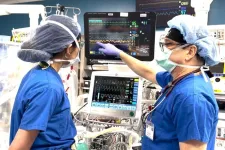(Press-News.org) Genetic mutations in human DNA can prevent proteins that perform important functions in the body from being formed correctly. This can lead to serious disorders that cause disease or even disability. Many of these diseases are already known and can be attributed to specific genes. To diagnose them, clinicians use a standard procedure known as exome sequencing. This involves analysing those segments of human DNA that are directly responsible for the correct formation of proteins. This coding part, the exome, makes up only around 1 per cent of the total DNA, but is particularly relevant.
“However, in two-thirds of cases, exome analysis does not lead to a diagnosis, which raises the question of what to do next,” says Professor Rami Abou Jamra. He is Professor of Medical Genomics at Leipzig University and Head of Genetic Diagnostics at the Institute of Human Genetics at the University of Leipzig Medical Center (UKL). “For patients and their families, a clear diagnosis means a great deal: not only does it confirm that the disease is not their own fault – it also paves the way for public recognition and, where possible, personalised treatment,” says the doctor.
In order to assess the benefits of genome sequencing compared to exome sequencing, scientists from the Broad Institute of MIT and Harvard and Harvard Medical School in Boston analysed 744 families. These were sick children with a suspected genetic disease, and their parents. In some of whom exome sequencing was already performed and failed to provide a diagnosis. The Institute of Human Genetics in Leipzig used genome sequencing to analyse 350 families in an independent patient cohort where exome sequencing had not shed any light. The first 78 cases were included in the joint study with the researchers in Boston.
Using a technique called short-read sequencing, the entire DNA, i.e. the genome, of all the families was cut into billions of small pieces and read. The researchers analysed the data using bioinformatics software and algorithms.
“Compared to exome sequencing, genome sequencing provided clarity in an additional 8% of cases: that is significantly more,” explains Professor Rami Abou Jamra, who led the study in Leipzig. “This method is particularly helpful if a genetic mutation that causes a disease is due to the absence of very small segments of DNA, the elongation of unspecific sequences, or if the mutation is not located in the coding part at all,” says the researcher, adding: “In exome sequencing, the coding regions are extracted from the DNA in the laboratory and chemically enriched, which unfortunately leads to a loss of quality and information.” But it is precisely this information that could provide crucial clues. In addition, gene segments outside the exome also have important functions, such as regulating mechanisms that control protein synthesis. These segments are completely overlooked by exome analysis. Ultimately, the researchers hope to identify new disease patterns and mechanisms by taking a comprehensive look at the entire genome.
“Our data suggests that genome sequencing should be used more quickly, especially when exome sequencing has not provided clarity,” says Professor Rami Abou Jamra. “In the past, there was a lack of certainty in the literature as to when genome sequencing was advisable. Now, thanks in part to the work carried out in Leipzig, the large dataset obtained shows that the results are definitely viable for clinical application,” says the scientist.
As Professor Rami Abou Jamra points out, another advantage of genome sequencing, although it is currently still around two and a half times more expensive than exome sequencing, is a long-term one: new genetic mutations associated with diseases are being discovered and documented all over the world, which means that once the genome sequencing data is available, it can easily be re-examined in the light of new knowledge.
And what’s next? “We will read more genomes, and we will do it all with an even more revealing technique called long-read sequencing” says a delighted Professor Abou Jamra. “We want to decode all genetic diseases.”
END
When is genome sequencing advisable?
When is genome sequencing advisable?
2024-06-10
ELSE PRESS RELEASES FROM THIS DATE:
Association found between media diet and science-consistent beliefs about climate change
2024-06-10
In a paper titled “The Politicization of Climate Science: Media Consumption, Perceptions of Science and Scientists, and Support for Policy,” published May 26, 2024, in the Journal of Health Communication, researchers probed the associations between media exposure and science-consistent beliefs about climate change and the threat it posed to the respondent.
Expanding on earlier work associating Fox News consumption with doubts about the existence of human-caused climate change, a team of scholars affiliated with the Annenberg Public Policy ...
Older, poorer, Black, Medicaid beneficiaries less likely to be placed on liver transplant lists
2024-06-10
INDIANAPOLIS – A new, healthy liver offers the best survival for patients with early-stage liver cancer. But a new study, led by Katie Ross-Driscoll, PhD, MPH, of Regenstrief Institute and Indiana University School of Medicine Department of Surgery, has identified disparities in liver transplant referral and evaluation, which must precede waitlisting, for these potentially lifesaving procedures.
While other studies have demonstrated disparities in placement on organ waitlists, the new study is one of the first to examine the transplant ...
Imposing cost-efficient trade sanctions
2024-06-10
By Alistair Jones
SMU Office of Research – Global condemnation of Russia over its invasion of Ukraine has prompted the imposition of trade sanctions. Such measures are a form of economic coercion, commonly used for reasons of foreign policy.
Trade sanctions can be put in place in an attempt to alter objectionable behaviour – in Russia's case, waging a war – or to punish an offending state through the disruption of economic exchange.
"Sanctions can be in many forms and raising ...
Statins for heart disease prevention could be recommended for far fewer Americans if new risk equation is adopted
2024-06-10
PITTSBURGH – If national guidelines are revised to incorporate a new risk equation, about 40% fewer people could meet criteria for cholesterol-lowering statins to prevent heart disease, according to a study by researchers at the University of Pittsburgh, Beth Israel Deaconess Medical Center and University of Michigan. Published today in JAMA Internal Medicine, the study examines the potential impact of widespread adoption of the PREVENT equations, which were released by the American Heart Association ...
Multicenter clinical study supports safety of deep general anesthesia
2024-06-10
General anesthesia makes it possible for millions of patients each year to undergo lifesaving surgeries while unconscious and free of pain. But the 176-year-old medical staple uses powerful drugs that have stoked fears of adverse effects on the brain — particularly if used in high doses.
New findings published June 10 in the Journal of the American Medical Association (JAMA), however, support an earlier study that indicates that anesthesia is no more hazardous for the brain at higher doses than at lower doses, ...
Cancer incidence trends in successive social generations in the US
2024-06-10
About The Study: In this model-based cohort analysis of incident invasive cancer in the general population, decreases in lung and cervical cancers in Generation X may be offset by gains at other sites. Generation X may be experiencing larger per-capita increases in the incidence of leading cancers than any prior generation born in 1908 through 1964. On current trajectories, cancer incidence could remain high for decades.
Corresponding Author: To contact the corresponding author, Philip S. Rosenberg, Ph.D., email rosenbep@mail.nih.gov.
To access the embargoed study: Visit ...
Global prevalence of overweight and obesity in children and adolescents
2024-06-10
About The Study: This study’s findings indicated 1 of 5 children or adolescents experienced excess weight and that rates of excess weight varied by regional income and Human Development Index. Excess weight among children and adolescents was associated with a mix of inherent, behavioral, environmental, and sociocultural influences that need the attention and committed intervention of primary care professionals, clinicians, health authorities, and the general public.
Corresponding Author: To ...
Severe pediatric neurological manifestations with SARS-CoV-2 or MIS-C hospitalization and new morbidity
2024-06-10
About The Study: The results of this study suggest that children and adolescents with acute SARS-CoV-2 or multisystem inflammatory syndrome in children (MIS-C) and severe neurological manifestations may be at high risk for long-term impairment and may benefit from screening and early intervention to assist recovery.
Corresponding Author: To contact the corresponding author, Ericka L. Fink, M.D., M.S., email finkel@ccm.upmc.edu.
To access the embargoed study: Visit our For The Media website at this link https://media.jamanetwork.com/
(doi:10.1001/jamanetworkopen.2024.14122)
Editor’s ...
Elephants have names for each other like people do, new study shows
2024-06-10
Colorado State University scientists have called elephants by their names, and the elephants called back.
Wild African elephants address each other with name-like calls, a rare ability among nonhuman animals, according to a new study published in Nature Ecology and Evolution.
Researchers from CSU, Save the Elephants and ElephantVoices used machine learning to confirm that elephant calls contained a name-like component identifying the intended recipient, a behavior they suspected based on observation. When the researchers played back recorded calls, elephants responded affirmatively ...
In a significant first, researchers detect water frost on solar system’s tallest volcanoes
2024-06-10
PROVIDENCE, R.I. [Brown University] — An international team of planetary scientists has detected patches of water frost sitting atop the Tharsis volcanoes on Mars, which are not only the tallest volcanic mountains on the Red Planet but in the entire solar system.
The discovery marks the first time frost has been spotted near the planet’s equator, challenging existing perceptions of the planet’s climate dynamics, according to the team’s new study in Nature Geoscience.
“We thought it was improbable for frost to form around Mars’ equator, as the mix ...
LAST 30 PRESS RELEASES:
Scientists boost cell "powerhouses" to burn more calories
Automatic label checking: The missing step in making reliable medical AI
Low daily alcohol intake linked to 50% heightened mouth cancer risk in India
American Meteorological Society announces Rick Spinrad as 2026 President-Elect
Biomass-based carbon capture spotlighted in newly released global climate webinar recording
Illuminating invisible nano pollutants: advanced bioimaging tracks the full journey of emerging nanoscale contaminants in living systems
How does age affect recovery from spinal cord injury?
Novel AI tool offers prognosis for patients with head and neck cancer
Fathers’ microplastic exposure tied to their children’s metabolic problems
Research validates laboratory model for studying high-grade serous ovarian cancer
SIR 2026 delivers transformative breakthroughs in minimally invasive medicine to improve patient care
Stem Cell Reports most downloaded papers of 2025 highlight the breadth and impact of stem cell research
Oxford-led study estimates NHS spends around 3% of its primary and secondary care budget on the health impacts of heat and cold in England
A researcher’s long quest leads to a smart composite breakthrough
Urban wild bees act as “microbial sensors” of city health.
New study finds where you live affects recovery after a hip fracture
Forecasting the impact of fully automated vehicle adoption on US road traffic injuries
Alcohol-related hospitalizations from 2016 to 2022
Semaglutide and hospitalizations in patients with obesity and established cardiovascular disease
Researchers ‘listen in’ to embryo-mother interactions during implantation using a culture system replicating the womb lining
How changing your diet could help save the world
How to make AI truly scalable and reliable for real-time traffic assignment?
Beyond fragmented markets: A new framework for efficient and stable ride-pooling
Can shape priors make road perception more reliable for autonomous driving?
AI tracks nearly 100 years of aging research, revealing key trends and gaps
Innovative techniques enable Italy’s first imaging of individual trapped atoms
KIER successfully develops Korea-made “calibration thermoelectric module” for measuring thermoelectric device performance
Diversifying US Midwest farming for stability and resilience
Emphasizing immigrants’ deservingness shifts attitudes
Japanese eels, climate change, and river temperature
[Press-News.org] When is genome sequencing advisable?When is genome sequencing advisable?




